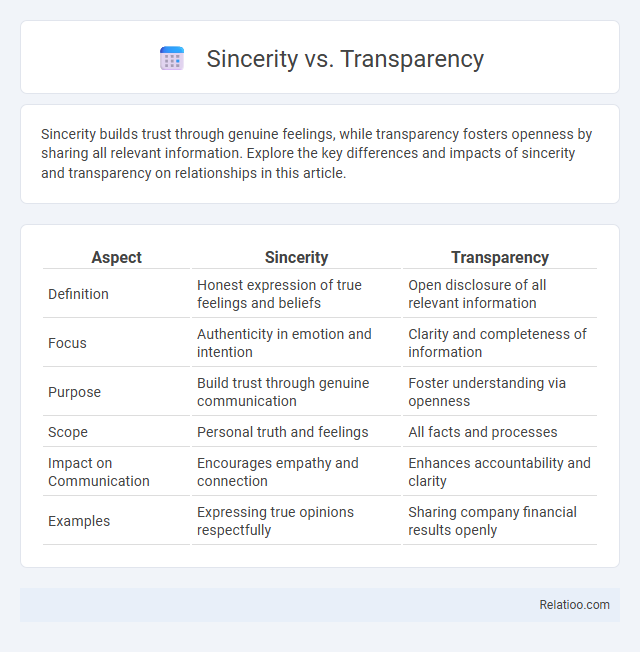Sincerity builds trust through genuine feelings, while transparency fosters openness by sharing all relevant information. Explore the key differences and impacts of sincerity and transparency on relationships in this article.
Table of Comparison
| Aspect | Sincerity | Transparency |
|---|---|---|
| Definition | Honest expression of true feelings and beliefs | Open disclosure of all relevant information |
| Focus | Authenticity in emotion and intention | Clarity and completeness of information |
| Purpose | Build trust through genuine communication | Foster understanding via openness |
| Scope | Personal truth and feelings | All facts and processes |
| Impact on Communication | Encourages empathy and connection | Enhances accountability and clarity |
| Examples | Expressing true opinions respectfully | Sharing company financial results openly |
Understanding Sincerity and Transparency
Sincerity involves genuine emotions and intentions expressed without deceit, fostering trust through authenticity in communication. Transparency emphasizes openness and clear sharing of information, promoting accountability by revealing processes and decisions. Understanding sincerity and transparency is essential for building strong relationships, as sincerity ensures honest feelings while transparency provides clarity and accessibility of information.
Key Differences Between Sincerity and Transparency
Sincerity involves genuine feelings and honesty in expressing emotions or intentions, reflecting an authentic inner state without pretense. Transparency refers to openly sharing information, processes, or decisions to ensure clarity and trust, often emphasizing openness over emotional depth. The key difference lies in sincerity being rooted in heartfelt truthfulness, while transparency centers on the visibility and accessibility of information.
Why Sincerity Matters in Communication
Sincerity matters in communication because it builds trust and fosters genuine connections, essential for meaningful interactions. Unlike transparency, which involves sharing all information openly, sincerity emphasizes honesty paired with authenticity, ensuring your messages resonate deeply and are perceived as heartfelt. Your sincere communication encourages openness and strengthens relationships by showing that you truly care about the impact of your words.
The Importance of Transparency in Relationships
Transparency in relationships fosters trust by openly sharing thoughts, feelings, and intentions without hidden agendas. Your ability to communicate honestly strengthens emotional bonds and reduces misunderstandings. While sincerity reflects genuine feelings, transparency ensures your partner fully understands your perspective, creating a foundation for lasting connection.
Sincerity vs Transparency in the Workplace
Sincerity in the workplace involves genuine honesty and heartfelt communication, fostering trust and authenticity among colleagues. Transparency emphasizes openness and the sharing of information, which encourages accountability and informed decision-making. Balancing your sincerity with workplace transparency creates a culture where employees feel both emotionally respected and well-informed, enhancing collaboration and productivity.
Challenges of Balancing Sincerity and Transparency
Balancing sincerity and transparency presents challenges such as maintaining authenticity while protecting sensitive information and respecting privacy boundaries. You must navigate the fine line between being honest and revealing too much, which can lead to misunderstandings or vulnerability. Effective communication requires aligning your genuine intentions with an appropriate level of openness to build trust without compromising discretion.
When to Prioritize Sincerity Over Transparency
Prioritize sincerity over transparency when emotional trust and genuine connection are essential, such as in personal relationships or sensitive communications. Sincerity emphasizes heartfelt honesty and authenticity, ensuring messages resonate on a deeper, more empathetic level. Transparency, focused on openness and full disclosure, may sometimes risk alienating or overwhelming audiences if not balanced with sincere intent.
The Risks of Excess Transparency
Excess transparency in organizational communication can lead to information overload, erosion of trust, and vulnerability to exploitation by competitors or malicious actors. Unlike sincerity, which involves honest and heartfelt expression, excessive transparency may expose sensitive data that compromises security and strategic advantage. Balancing transparent practices with prudent discretion helps maintain integrity while protecting critical assets and relationships.
Cultivating Both Sincerity and Transparency
Cultivating both sincerity and transparency fosters trust and authenticity in personal and professional relationships by ensuring honest intentions align with clear communication. Sincerity involves genuine feelings and intentions, while transparency requires openly sharing information and decisions, creating an environment of mutual respect and accountability. Balancing these qualities enhances credibility and fosters deeper connections by minimizing misunderstandings and promoting ethical interactions.
Practical Tips for Harmonizing Sincerity and Transparency
Balancing sincerity and transparency requires clear communication that respects both honesty and openness without oversharing. You can foster trust by expressing genuine feelings while maintaining appropriate boundaries to protect privacy and build credibility. Practical tips include active listening, thoughtful wording, and consistent follow-through to ensure your message is both heartfelt and clear.

Infographic: Sincerity vs Transparency
 relatioo.com
relatioo.com